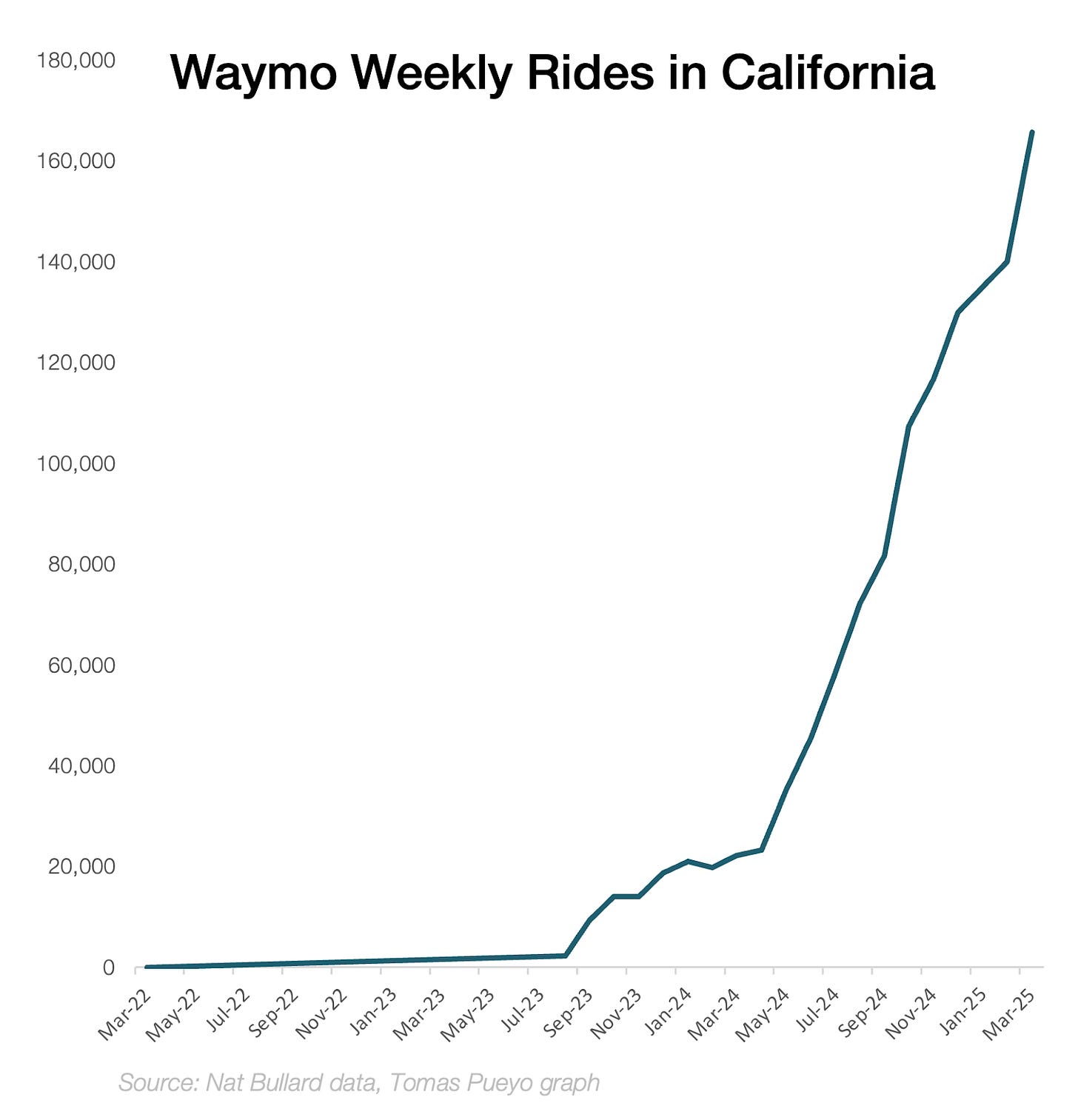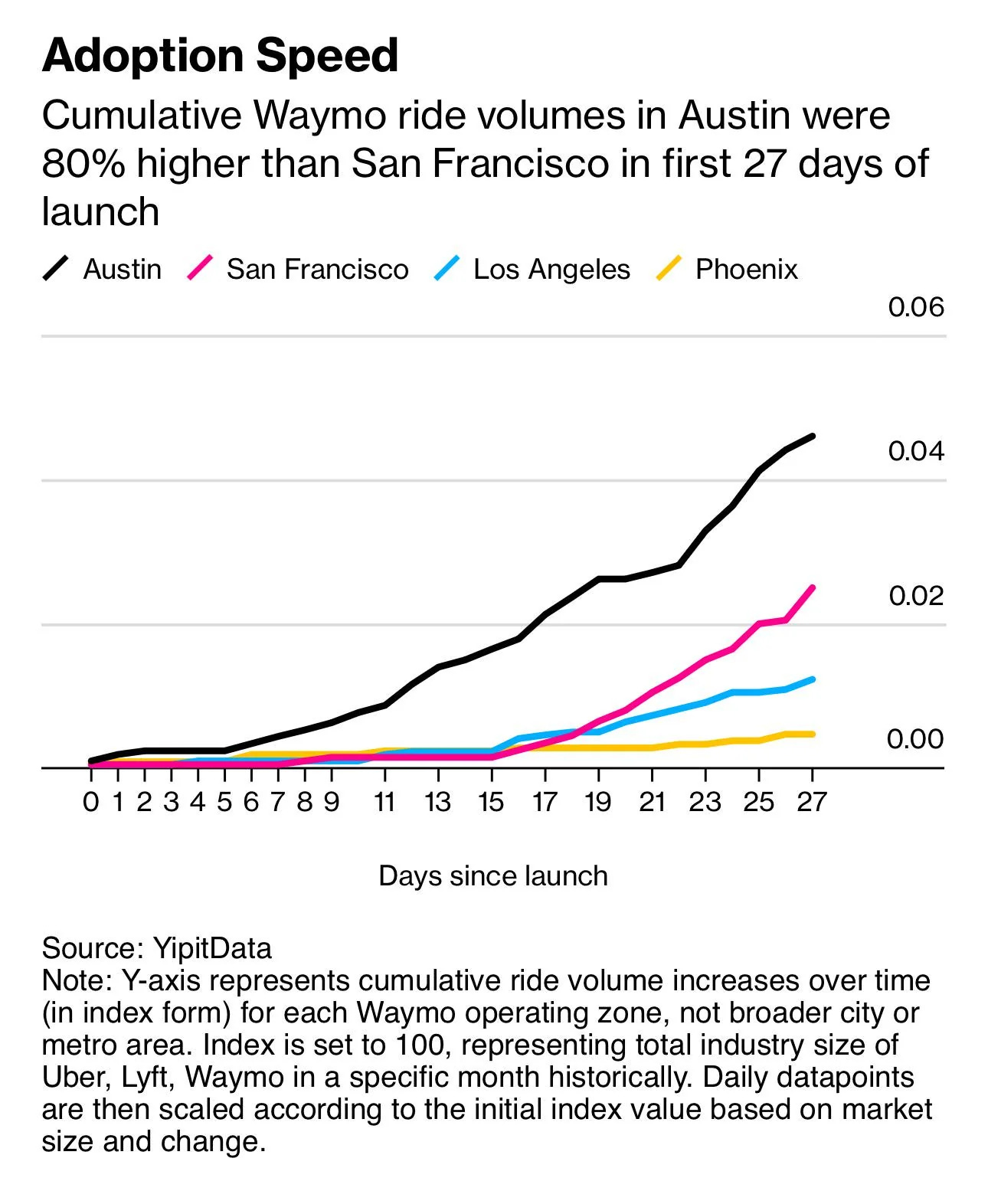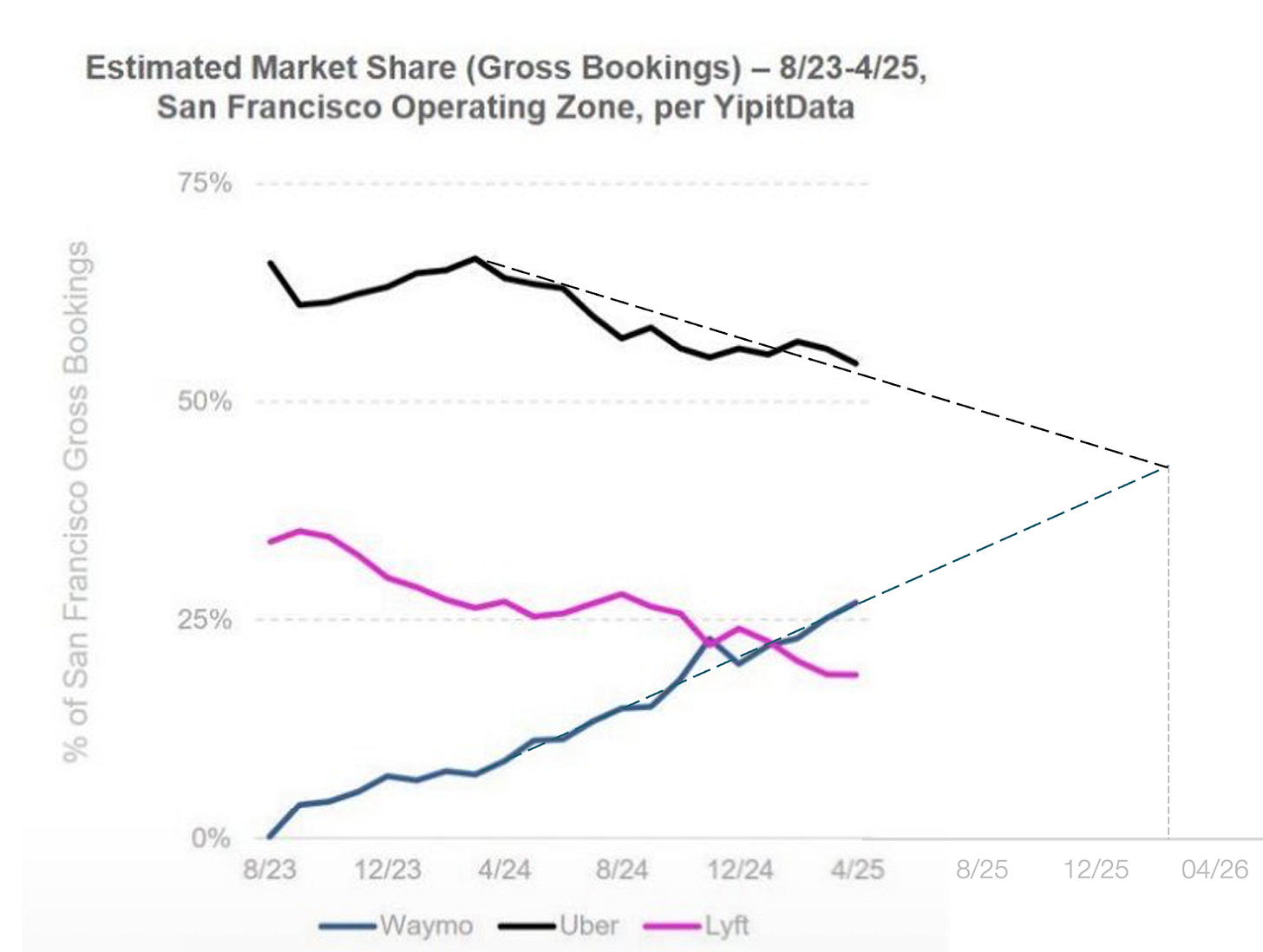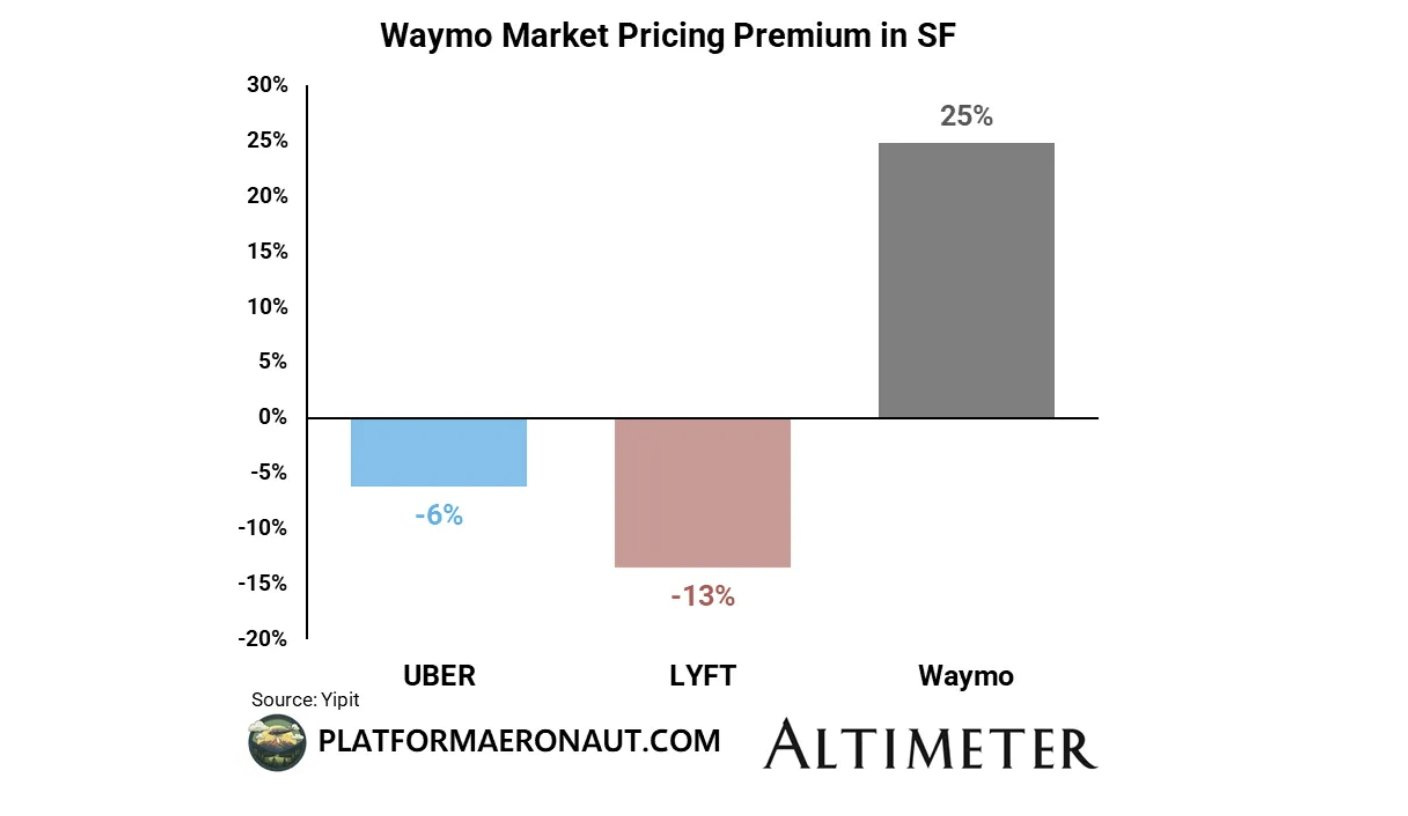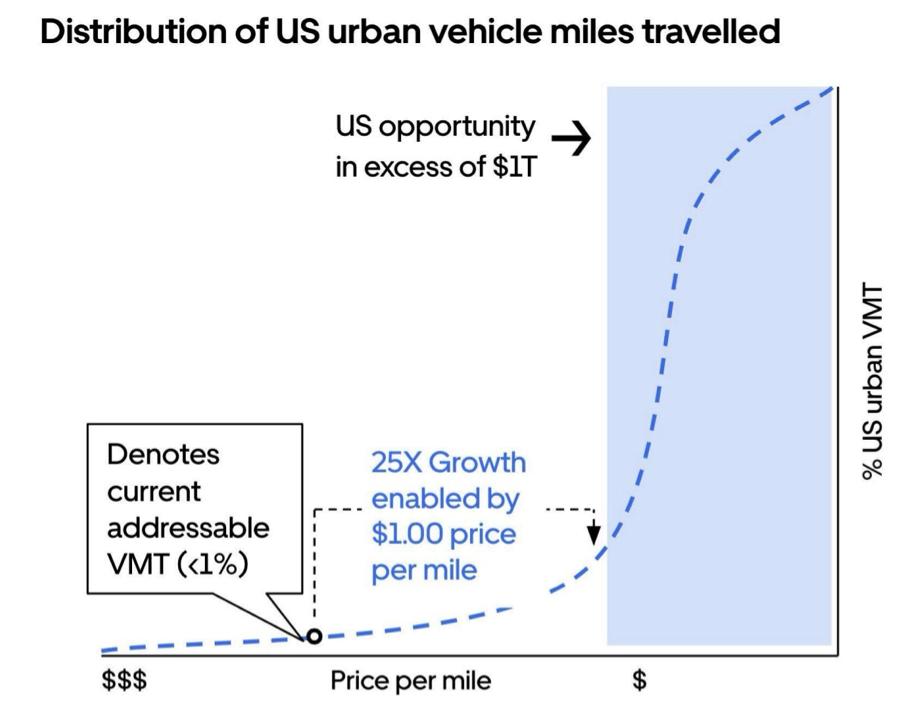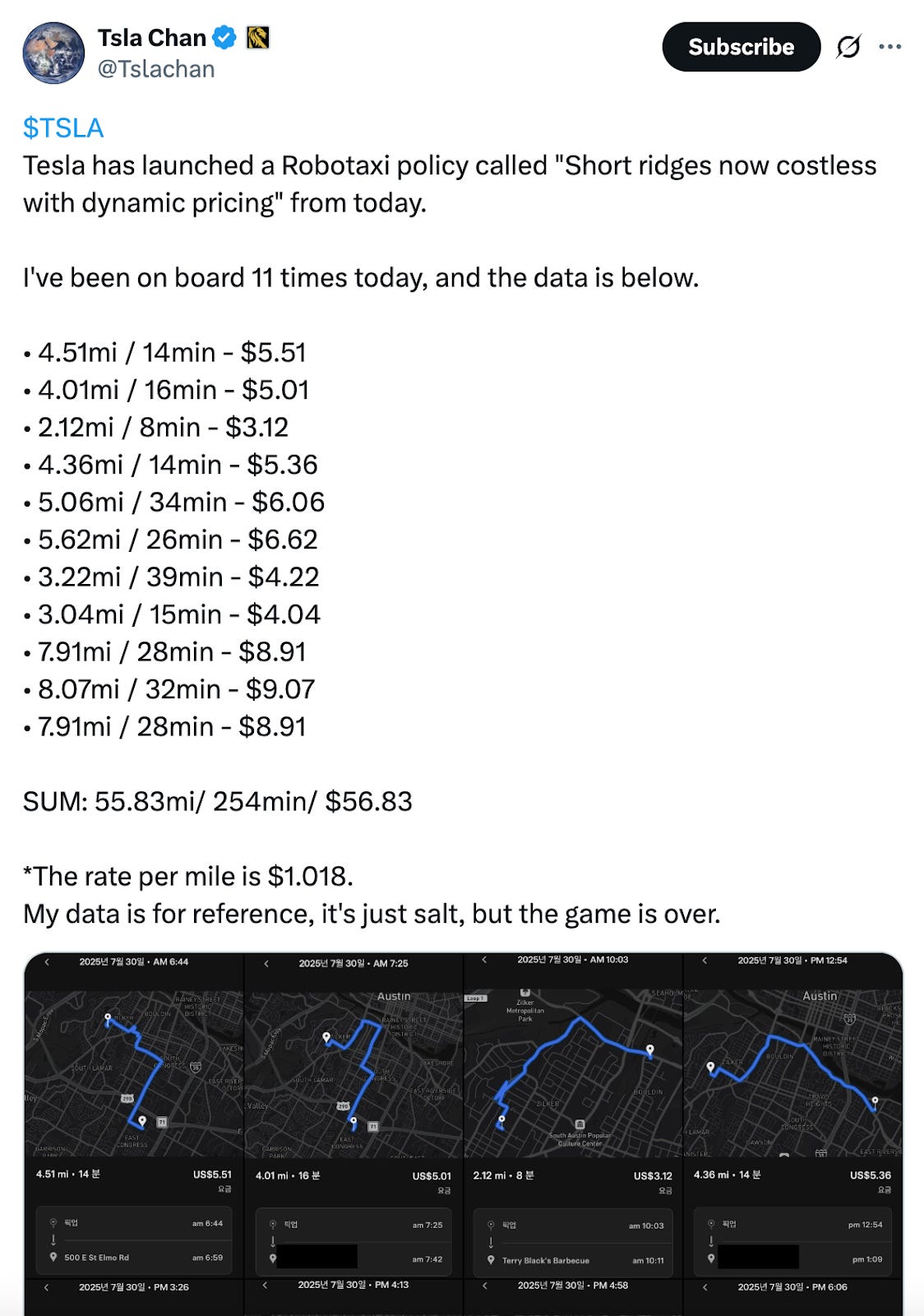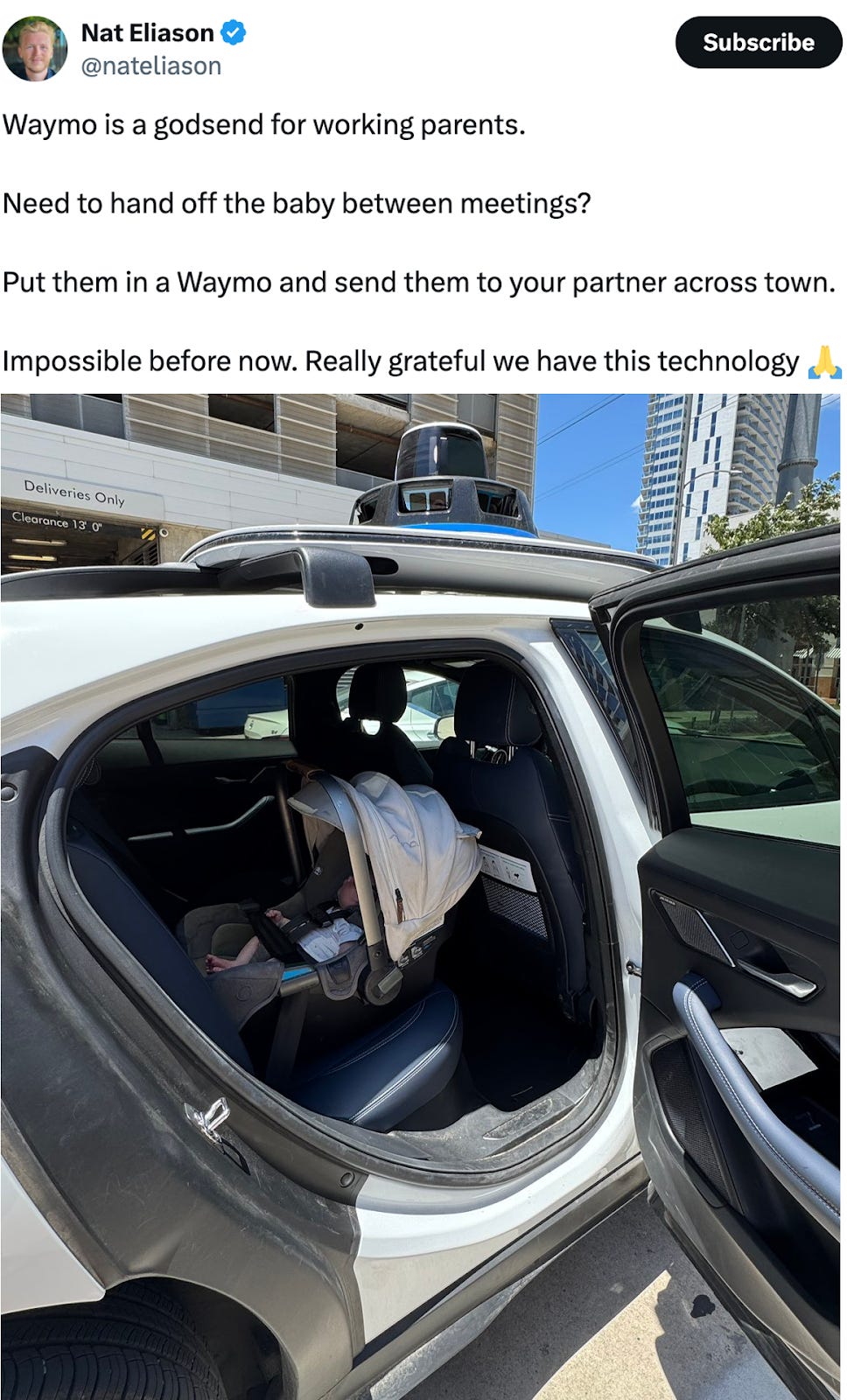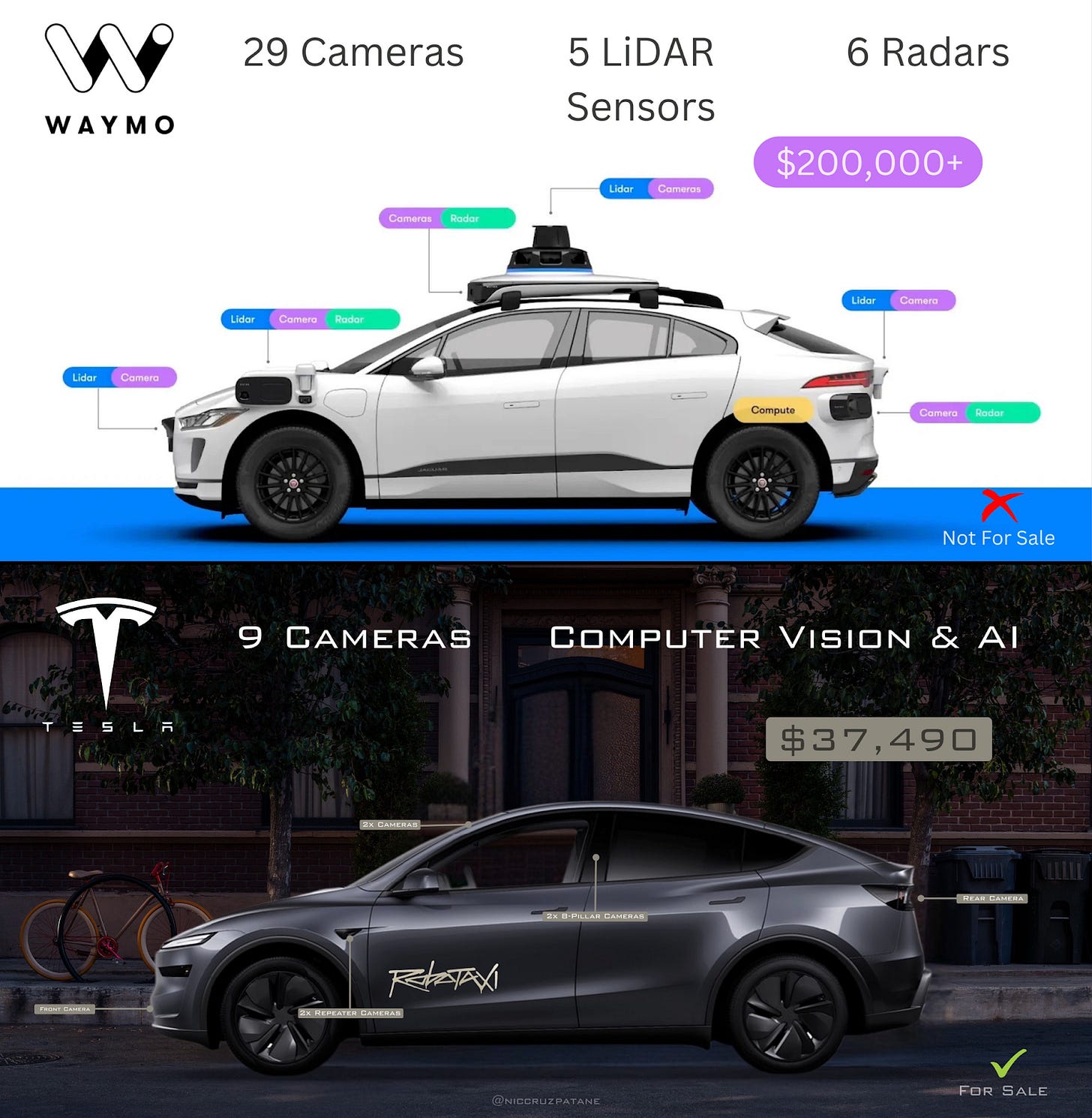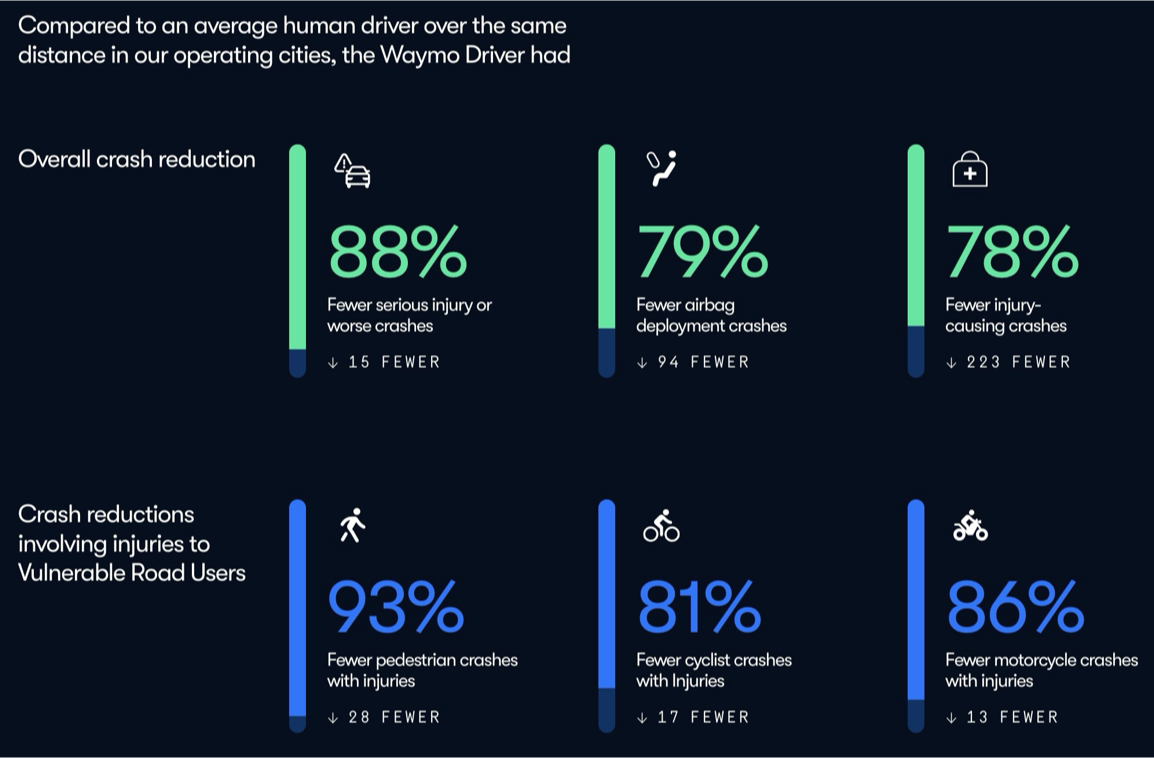Robotaxis & AI | Uncharted Territories Magazine | Tech Update Summer 2025
Catching up on articles from the previous weeks, today we’re covering the most important things that have been happening in the world of Robotaxis and AI since we last discussed them six months ago.
Robotaxis
In Robotaxis Are Here, I explained why they’re arriving, why they’ll broaden their spread in the next 1-3 years, and why Tesla is best positioned to win that market. As a fast-moving trend, we need to track it closely.
Gaining Momentum
Here are Waymo’s weekly rides, just in California:
And adoption is faster in Austin:
That makes sense: A lot of hesitance comes from ignorance. The more Waymo proves itself and people learn about it, the faster they’ll adopt it. Soon enough, we’ll see people begging Waymo to enter their market.
Waymo just entered Atlanta, by the way, will open soon in Miami and DC, and is collecting data in Las Vegas, Dallas, San Antonio, Nashville, New Orleans, and several other metros. It now takes only 1-2 years from mapping vans to credit-card rides.
And Waymo is destroying the competition. It has surpassed Lyft in rides in SF, and is on track to surpass Uber within 8 months or so:
And this is with Waymo taking 2x longer and costing 70% more than Lyft!!!1 That’s how much better the Waymo experience is: People really care about not having a driver!
Robotaxis Will Expand the Market
But the bigger story is not just that they’re going to crush the competition. It’s that robotaxis will make the market size explode. Uber said ride-hailing could grow by 25x if its price dropped under $1/mile.
By replacing other private rides with ride-hailing:
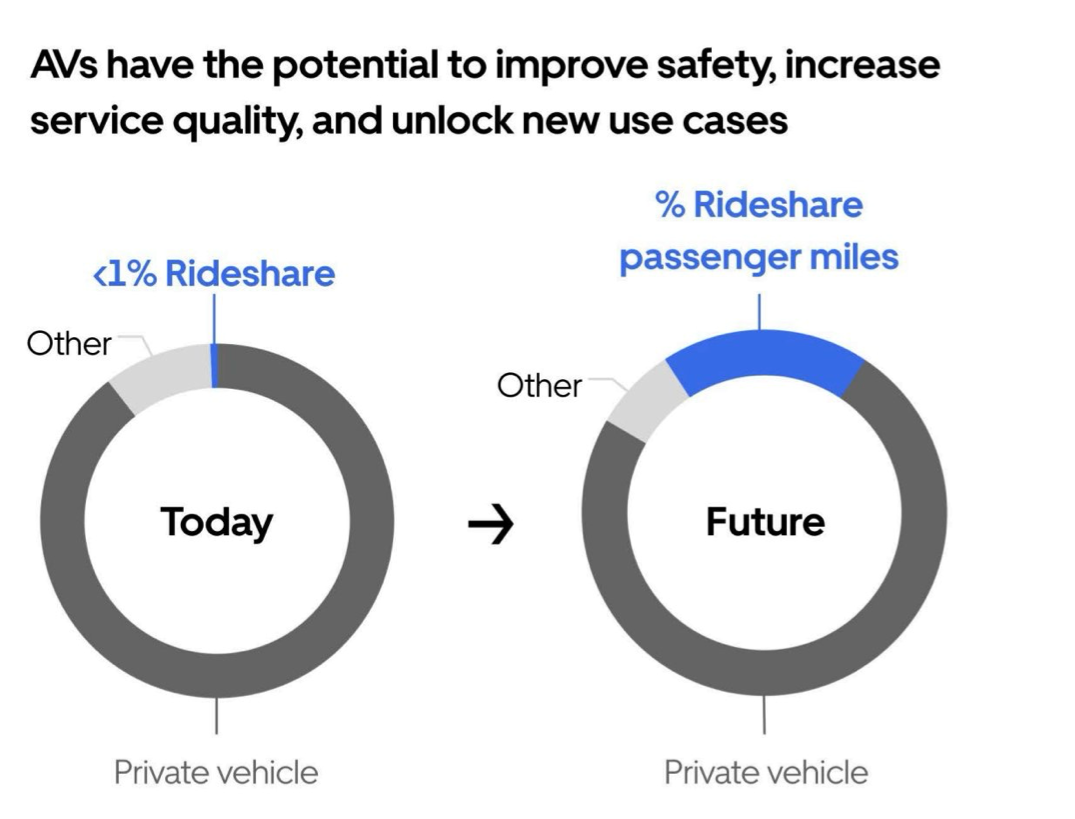
Uber couldn’t make it happen. But in Austin, now Tesla costs $1 per mile:
As a comparison, ride hail customers are currently paying nearly $3/mile…2
If Tesla maintains this type of pricing, it won’t make sense for drivers to continue their job, and Uber and Lyft will crash.
8% of US workers are professional drivers.
New Use Cases
I maintain that robotaxis will first grow by replacing cabs, then by taking new use cases that were previously impossible—like the one below. I’m not sure whether it’s a joke or not… Yet. If this tech works reliably, it’s a matter of time before it becomes more widespread:
Waymo vs Tesla
LiDARs vs Vision
A key input is going to be the cost of each car: The cheaper they are, the cheaper the price tag can be, and the more competitive they will be. And Tesla’s cars will be nearly an order of magnitude cheaper than Waymo’s:
According to this Tesla analyst:
In the recent testing of 36 vehicles in China, vision-only Full Self-Driving beats all the leading systems with LiDARs incorporated. Separately, CEO Robin Li recently alluded to Baidu’s transition to vision-only approach while Xpeng is in the early stage to phase out Lidars.
Safety
Are politicians criminals for slowing down the adoption of robotaxis, when these cabs reduce crashes and injuries by one order of magnitude?
In clinical trials, when it's obvious that a treatment is much better than the tested alternative, it's considered inhumane to continue subjecting people to that alternative. There are rules for early stoppage of clinical trials. Shouldn't we do the same here?
With the data we have today, we should not be saying "Let's be cautious with robotaxi rollout. We should be asking: "What can we do to accelerate their deployment? Millions of lives are at stake."
I didn’t realize how important this is until I read this article:
Something like 40,000 people die in traffic accidents in the US every year. The number is over one million per year globally.
There are over 5 million non-fatal injuries from car crashes each year that require medical attention in the US.
In 2010, the total costs from these events was $836 billion, or ~$2700 per American per year.
But these costs are just the tip of the iceberg because most of the cost of transportation, at >$2 trillion per year, comes from adjusting to human inadequacies.
Wait, what? Car accidents are costing trillions to the world economy?3 How?
A big share of the materials in cars are due to safety. Without accidents, you can strip them out, saving all their money. Austin Vernon calculates we could make car weights 10x lower.
Automobile shapes today trade off safety and aerodynamicity. Without safety, they can become more aerodynamic, and move faster at a cheaper cost.
Cheaper transportation costs massively improve the economy.
Lower weights on roads means less road wear, and hence less maintenance cost.
Other Consequences
Many from the same article:
Robotaxis are much more likely to be electric, because that will make them cheaper per km. This means much less oil consumption, and oil countries will suffer accordingly.
Goldman Sachs says insurance costs will be halved. It’s probably much more than that, because cars that have fewer accidents will also be lighter, so the gravity of their impacts, when they happen, will be lower.
Looking for parking will be a thing of the past. That’s a $150B industry worldwide. This also means homes and apartment buildings will be cheaper: Building a parking spot costs $28k. And streets won’t be littered with parked cars anymore. We will be able to reclaim this space for pedestrians. On the flip side, cities will lose a huge source of income. NYC currently makes nearly $1B/year from parking meters and parking violations!
Maintenance of electric cars is already much lower than for internal combustion engine cars. If you add to that lower car costs, demand for them will increase. The economies of scale will mean cars will be so cheap, it might make more sense to replace them than repair them. Mechanics basically disappear.
Pollution plummets: not just combustion, also tires and road wear, which account for a big part of pollution!
Noise plummets. City streets get reclaimed, with more people walking on them and sitting on the sidewalk to hang out.
People will own several of these: for groceries, children, food takeaway…
Poor people will have an access to transportation previously unheard of.
It might be easier to have more children, as children’s extracurriculars won’t entail parents acting as cab drivers all day long.
Public transportation might become outdated.
Some cars will be adapted to commutes (more aerodynamic), others to older people (more ergonomic), others to other groups.
Learning to drive will be a thing of the past.
Traffic jams will shrink, as this type of car will be smaller, and AI drivers will need less safety distance.
Trucks lose the cabin, and become just a surface with wheels
All in all, it feels like Waymo is trying to expand fast in the US, it will gain tremendous market share as it does, but it won’t fundamentally undermine the model of robotaxis. If Tesla succeeds in its markets, it will drop the price, drive competitors out, take over the market, and expand it by at least one order of magnitude. As this revolution takes place, our daily lives will change dramatically.
OK, now let’s look at AI: Where it is, where it’s going, the risks, and more.


